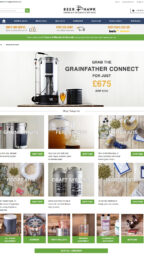When we talk about trust in websites, we could be referring to any number of things. Typically, website users are taught to look for a number of tell-tale signs as to whether or not the website they are using is safe (or trustworthy).
Safe and Secure
At the top of the list is usually the “padlock”. Does the website show a padlock in the left hand corner of the address bar? If it doesn’t, it is likely that any data you provide is not encrypted and could be intercepted. Checking for a padlock is good advice, the padlock shows that the site you are using has a valid SSL certificate and that it is secure. In some cases Google is starting to exclude sites that do not have an SSL certificate from its search results and, in other cases, is warning searchers that the site it is sending them to might be insecure.
Word of Mouth
Another sign that promotes trust within a website is reviews. Reviews show visitors how other users have found the experience of working with this organisation. Reviews validate the business and can give people confidence that the product or service they are about to purchase or order will be as described, the quality will be as they expect it to be, it will actually be delivered and what the companies customer service department is like.
It’s All Well and Good Ticking the Boxes…
All the usual methods of earning trust from an online visitor are absolutely necessary. These are the things that people are taught to look out for and if you don’t have at least an SSL certificate, then you are likely losing out on valuable traffic and conversions. However, it’s all well and good taking these steps to gain the trust of your visitors, but if your website is poorly designed, hard to use, frustrating, or generally not very pretty to look at, your customers still won’t trust you.
A website, whether it sells a product, a service or is there to provide information, is just like a physical store, if its not appealing to your audience, then it will lose business.
Think of it this way; it’s Friday night, you’ve had a busy week and you want to treat the family to a take away. You check out Tripadvisor to see what’s good in the area and the local Chinese has great reviews. Everyone is raving about the food and how great the service is and you can see that they have a great food hygiene rating. So, you hop in the car and make your way over. When you get there, there are a couple of dodgy looking characters hanging around outside, it puts you off slightly, but you squeeze past and make your way inside. As you open the door, a rancid smell smacks you in the face. You proceed to the counter wading your way through, what looks like, rat droppings and when you get there the hygiene of the person impatiently waiting to take your order seems questionable. Are you still going to place your order? Or are you going to try the other place a few doors down, that looks a bit newer and seems much nicer?
If the answer is “I’m going to try the nicer looking place down the road”, then read on. If not, then take a long, hard look at yourself in the mirror and consider getting some help.
Decide for yourself…
Take a look at these two sites:
Exhibit A.

Exhibit B.

Exhibit A is the website of a company that provides holiday courses for children. Exhibit B provides… exactly the same thing, in exactly the same areas. Neither of the websites have official reviews, but Exhibit B does have some testimonials. They both have a valid SSL certificate and show the secure padlock (at least on the booking/payment page). Which one would you feel safer handing your details over to? The answer is Exhibit B, and if you disagree, then take a long, hard look at yourself in the mirror and consider getting some help.
Example 2
You are in the market for some home-brewing equipment, these two websites sell exactly the same products, for roughly the same prices:
Exhibit A.

Exhibit B.

Which one do you buy from? Exhibit A, right? It’s much nicer, seems more trustworthy and is generally more pleasing on the eye. What if I told you that it isn’t secure and doesn’t have the padlock in the address bar? Did you even notice, or just make your decision on how the site looks? (It does, by the way, so don’t bother checking, I’m just trying to prove a point).
What is the Point I am Trying to Prove?
My point is, if your website is secure and has trusted reviews, but doesn’t look as good as your competitors, then you are going to lose business.
If your website looks great but isn’t secure, you will be losing out on business too and you should definitely consider upgrading your hosting, especially if you want to comply with (and you 100% should) the new General Data Protection Regulation (GDPR) that comes into play on 25th May 2018.
If your website isn’t secure and looks terrible, then you need to take a long hard look at yourself in the mirror and consider getting some help!
